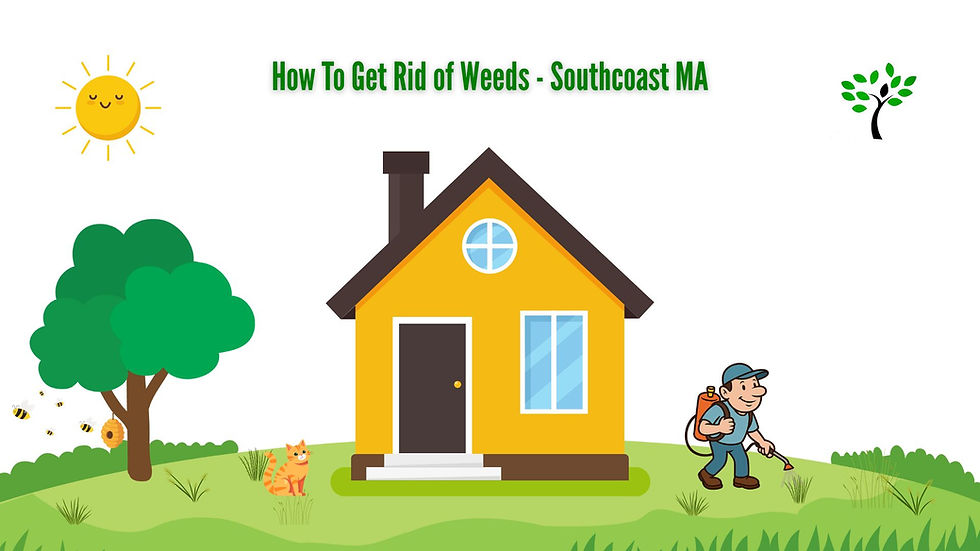How To Get Rid of Weeds
- jmelo67
- Aug 15
- 4 min read
By Jorge Melo

Weeds can take over a yard fast. They steal water, sunlight, and nutrients from your grass and plants, leaving your lawn stressed and unhealthy. The key to getting rid of weeds is simple: remove them early, pull the roots completely, and stop new seeds from sprouting. That means combining smart prevention with the right removal method. In our 35 years of business, we’ve seen the most successful lawns managed with a mix of hand-weeding, mulching, selective herbicides, and proper lawn care practices. If you want lasting results, don’t just rip weeds at the surface—dig them out, fix the soil, and reseed the bare spots so they can’t return. Whether you’re fighting crabgrass, dandelions, or nutsedge, the process is the same: identify, remove, and prevent. In this guide, I’ll walk you through the best strategies for lawn care in Mattapoisett, MA, Rochester, MA, and nearby towns.
Understanding Weed Growth and Prevention
Weeds thrive where grass or desirable plants struggle. Poor soil, compacted ground, too much shade, or improper mowing create opportunities for weeds to spread. Prevention starts with healthy lawn care—dense, strong turf naturally shades the soil, blocking sunlight that weed seeds need to germinate. Mowing at the right height, watering deeply but infrequently, and feeding your soil with the right nutrients all make it harder for weeds to take hold.
Common Types of Lawn Weeds
Broadleaf Weeds
Easily spotted because of their wide, flat leaves. Examples: dandelions, clover, chickweed, and plantain. They often have deep taproots, so partial removal means they’ll grow back.
Grassy Weeds
These resemble turfgrass but grow in clumps or different shades. Examples: crabgrass, annual bluegrass, foxtail. They spread fast and can be hard to remove without harming your lawn.
Sedge Weeds
Often mistaken for grass, sedges have triangular stems and sets of three leaves. Examples: yellow nutsedge, purple nutsedge. They spread underground, making them tough to eradicate by pulling alone.
Natural Weed Control Methods
Hand-Weeding
Best for small areas or isolated weeds. Moist soil makes it easier to remove the whole root.
Pulling Weeds Permanently
Step 1: Get to the Root
Loosen soil around the weed with a spade or dandelion digger.
Step 2: Removal
Pull gently from the base, removing the entire root system.
Step 3: Smooth and Seed
Fill the hole with compost or seed to prevent new weeds from sprouting.
Spreading Mulch
Blocks sunlight, retains moisture, and suppresses weed growth around plants and trees.
Applying Corn Gluten Meal
Acts as a natural pre-emergent, stopping annual weed seeds from rooting. Apply early in spring and reapply every 4–6 weeks.
Flame Weeding
Uses heat to kill weeds between cracks or in gravel areas—avoid using near flammable materials.
Homemade Solutions
Options like vinegar or boiling water can kill weeds in non-lawn areas, but they may harm surrounding plants.
Synthetic Weed Control Options
Pre-Emergent Herbicides
Prevent weed seeds from germinating—best applied before weeds appear.
Post-Emergent Herbicides
Target actively growing weeds. Selective types kill weeds without harming grass; non-selective types kill everything they touch.
Weed and Feed Products
Combine fertilizer with herbicide, but timing must match both feeding and weed control
Tools for Effective Weed Removal
Manual Weed Removal Tools
Dandelion diggers, hori-hori knives, and hand cultivators for precision work.
Mechanical Weed Control Devices
Weed whackers, scuffle hoes, and power cultivators for larger infestations.
Maintaining a Weed-Free Lawn
Proper Mowing Practices
Set mower height according to grass type—taller grass shades the soil and discourages weeds.
Watering Strategies
Deep, infrequent watering encourages deep grass roots that outcompete weeds.
Soil Health Management
Test soil regularly and amend with lime or nutrients as needed to create optimal growing conditions.
Dealing With Stubborn Perennial Weeds
Addressing Specific Perennials
Identify and target weeds like nutsedge or bindweed with specialized removal techniques.
Biocontrol Agents
Some insects target specific weeds and can be introduced for natural control.
Preventing Weed Regrowth
Regular Monitoring and Maintenance
Inspect your lawn weekly, reseed bare spots, and apply pre-emergents each spring.
Everything You Need To Know About Weed Removal
Identifying Weeds
Look for growth patterns, leaf shapes, and root systems to choose the right removal strategy.
Can They Be Stopped Completely?
No, but with consistent control methods, their spread can be drastically reduced.
Removal Of Weeds
Removal by Hand
Effective if done early and roots are fully removed.
Times When Removal By Hand Will Be Difficult
Deep-rooted perennials, compacted soil, and large infestations often require tools or herbicides.
Mulches
Organic mulch or landscape fabric can block light and reduce weed germination.
Which Weeds Are Poisonous
Plants like poison ivy, poison hemlock, and giant hogweed can cause skin irritation or worse—wear gloves and protective clothing when removing.
Which Weeds Are Good
Some, like clover, can fix nitrogen in soil and benefit turf health.
Which Weeds Are Edible
Dandelion greens, purslane, and chickweed can be eaten if pesticide-free.
Are Weeds Poisonous to Dogs
Yes—plants like foxglove, milkweed, and buttercups can be toxic to pets.
How Weeds Grow
Weeds spread through seeds, underground runners, or tubers, making early removal critical.
Why Weeds Should Be Removed
They steal resources from desirable plants, harbor pests, and reduce lawn or garden health.
FAQ: Removing Weeds
Q: What’s the fastest way to kill weeds? A: For small areas, hand-pulling after rain works best. For large areas, selective herbicides or solarization are effective.
Q: How often should I weed my lawn?A: Weekly during peak growing season, especially in the first 2–3 years after planting.
Q: Can New England Tree & Landscape help with weed control? A: Yes—we offer complete lawn care in Mattapoisett, MA, Rochester, MA, and surrounding areas.
Q: Do you only serve large properties? A: No, we work with both residential and commercial clients, tailoring our approach to each property’s needs.
Citations
Allen, Monique. “How to Weed Your Garden Like a Pro: Part I.” The Garden Continuum, Sept. 2016.
Ocone, Lynn. “How to Get Rid of Weeds.” This Old House, 3 Oct. 2024.
Tucker, Acadia. “Getting Rid of Weeds Without Herbicides.” Stone Pier Press, 2025.
UC IPM. “General Methods of Weed Management.” University of California Agriculture and Natural Resources, July 2020.
Way, Simon. “Everything You Need to Know About Weed Removal.” Daitool, Nov. 25, 2024.




Comments